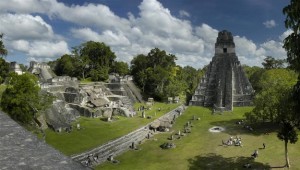Climate change is a hot button issue in today’s society. Rising sea levels, disappearing forests, and depleted ozone make headlines as indicators of a society headed towards death by its own hand. Many blame human activity; chlorofluorocarbons destroy the ozone layer, while carbon dioxide emitted by cars and factories causes a greenhouse effect that melts polar ice to and causes sea levels to rise.
While the evidence supporting climate change as a consequence of human activity is strong, it has its opponents. Many argue that global temperatures fluctuate often, and that recorded human history is not sufficient to draw any conclusions about the causality link between rising temperatures and human activity. How, then, do we deliberate between who is right and wrong? As it turns out, Archaeology can help.

The Yucatan Peninsula was home to the Mayans until their sudden collapse either during the 8th or 9th century.
The Mayan people arrived in the Yucatan area sometime between 2600 and 1800 B.C.E., growing to 19 million before their collapse around the 8th century. What could have been the reason for a mass exodus of tens of millions from some of the most populated cities in existence at the time? Some propose disease, some foreign invasion; new evidence, however, points to climate change.
Researchers at Arizona State University analyzed archaeological data from the Yucatan Peninsula during the fall of the Mayans. Their findings: during this time, deforestation for agriculture coincided with a severe reduction in rainfall. Additionally, there was a large demand for wood to fuel fires that cooked the lime plaster that was a staple in Mayan construction; some experts figure that each square meter of cityscape required the destruction of 20 trees.
At Columbia University, researchers used data from the region to construct a computer model to simulate the conditions during the Mayan collapse. They found that cleared lands absorb more water, thereby reducing the presence of clouds and rainfall. Their model estimated that deforestation accounted for roughly 60 percent of the total drying that occurred in the area during the time in question (the other 40 percent was a naturally occurring drought).

Large Mayan cities like Tikal (pictured above) became poor in the absence of trade, causing many to flee.
Drought on such a large scale in an area with such a high population density was catastrophic. Trade moved from overland routes through the heart of the Mayan civilization to sea-based routes around the peninsula. The Mayan cities relied on trade as a source of income, and the elite that ran those cities relied on it for power. Without trade, Mayan cities became poor and powerless. Peasants fled the cities to avoid starvation, leaving us with the ruins we see today.
The Mayans existed when human activity had done little to alter the earth. With no other external factors at play, deforestation was introduced, and the Mayan civilization collapsed shortly thereafter. This suggests that climate change can in part be blamed on human activity. The archaeology of climate change is important for this reason: the first step in fixing a problem is determining whether or not the problem actually exists. Archaeology and the Mayans have brought us one step closer to the answer.
Sources
Futher Reading

Knowing how and why civilizations like the Mayans or Aztecs collapsed several thousand years ago is key to human survival today especially since we are facing similar issues. Archaeologists that investigate climate change in the past are seeking to answer questions about how we can respond to our planet’s current state of a shifting climate that can threaten the longevity of the human population.